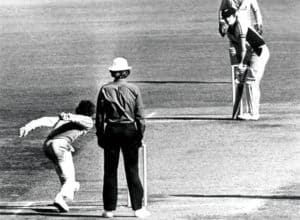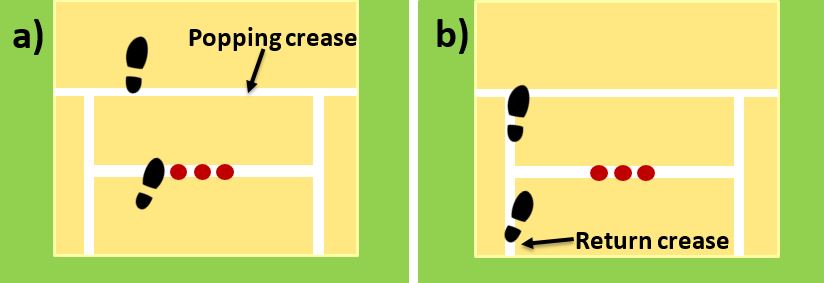In my opinion cricketers should try to have knowledge of as many cricketing laws as they can, and this is especially the case when it comes to different types of no ball. A no ball is a ball bowled that doesn’t lie within the rules of the game, and therefore needs to be bowled again. Bowling multiple no balls can be incredibly costly to the fielding side as the opposing team will always be awarded a penalty run for each no ball bowled. They will also have another chance to score off the additional ball that their team is given! Bowlers that repeatedly bowl certain types of no ball can even be stopped from bowling for the rest of the innings!
There are 10 different ways a bowler can bowl a no ball. Causes of these include:
- Incorrect declaration of delivery
- Throwing the ball (both before and during the delivery stride)
- Bowling underarm
- Overstepping the popping or return crease
- Breaking the wicket whilst delivering the ball
- Causing ball to bounce multiple times, or pitching it off the pitch.
- Fielder intercepting a delivery
- The ball bouncing too high
- Bowling a full toss over waist height
- Bowling that is deemed dangerous
In this post I’m going to take you through the finer details of each of these, as well as some famous incidents involving them. We’ll also look at some of the other causes of no balls that aren’t necessarily the fault of the bowler!
Different types of No Ball
Incorrect Declaration of Delivery
At the start of a spell of bowling, the umpire will ask the bowler to declare how he intends to bowl. He is looking for the bowler to give him two pieces of information:
- Which arm the bowler will be using to bowl
- From which side of the wicket he will be bowling (usually called either ‘over the wicket’ or ‘round the wicket’)
If you’re reading this and you’re not sure what the difference between over and round the wicket is, then here is the explanation. If you’re a right-handed bowler then bowling from the left side of the umpire is classed as over the wicket and bowling from the right side of the umpire is classed as round the wicket. The opposite is true for left-handed bowlers. An easy way to remember this is that if your bowling arm is the closest arm to the set of stumps at the non-strikers end then you are bowling over the wicket. Your bowling arm is basically ‘over’ the wicket when you bowl in this way.
Once the bowler has declared the way he will be bowling to the umpire, he must again inform the umpire any time he wishes to change this. Failure to do so will result in the umpire calling and signalling a no ball which requires an extra ball to be bowled and a run to be added to the batting team total. The signal for a no ball can be seen in the photo below.

So if you’re bowling over the wicket and decide to go round the wicket for the next ball, make sure you give the umpire a tap on the shoulder to let him know!
Throwing the Ball
There are two different ways no balls can be given for bowlers ‘throwing’ the ball.
Firstly, an umpire has the authority to declare a no ball if he feels that the bowler has bowled the ball illegally due to ‘throwing’. For a delivery to be seen as legal, the bowler must go through his delivery stride and from the moment the bowling arm rotates and reaches the level of the shoulder, the arm should either be completely or partially straight. Bowlers are legally allowed a bend of up to 15 degrees in the elbow joint when they deliver the ball. If the umpire believes he has witnessed the bowler bending his arm more than this allowed limit then he can label the resulting delivery a ‘throw’. He will then call and signal a no ball and warn the bowler. If the umpire sees the ball has been ‘thrown’ by the same bowler for a second time, a no ball will again be called. However, this time the umpire can call over the fielding teams captain and order that the bowler is suspended from bowling for the rest of that innings.
Note: The bending of the arm spoken about during the above paragraph only applies to the elbow joint. Bowlers are allowed to fully flex and rotate their wrists in order to deliver the ball.
There is also another type of ‘throwing’ that can result in a no ball, however this is slightly different and much less common when compared to the example I gave above. This one refers to the bowler throwing the ball towards the striking batsman before he enters his delivery stride. If the umpire judges that this has taken place, then he can again call and signal a no ball.
Bowling Underarm
This one is very simple…bowlers are not permitted to bowl underarm under normal circumstances unless a special agreement has been made by both teams prior to the match beginning. If the umpire sees the ball being bowled underarm then he will follow the same procedure as he would when he notices the bowler throwing the ball. In the first instance, no ball will be called and signalled and the bowler will be warned not to repeat this bowling motion. If the bowler does commit the same offence again, then no ball will be called and signalled for the second time, and the bowler will be suspended from bowling for the rest of the innings.
Underarm deliveries were banned as a result of the famous controversy caused by Trevor Chappell of Australia in 1981! The chances are if you’re a massive cricket fan you may have heard about this already, but if not then here’s a brief explanation of what happened: New Zealand needed 6 runs from the final ball of the game to draw the match against Australia, when Trevor’s brother Greg (captain of Australia at the time) instructed him to bowl the ball underarm. This resulted in the ball rolling gently along the floor to the batsman and meaning he had absolutely no chance to hit the runs that would have saved the game. As you would expect, the crowd started to boo loudly and both batsman walked off in disgust. Although at the time this underarm ball was a legal delivery, the Australians took an incredible amount of criticism for not playing cricket in the correct spirit. After this event the ball was made illegal…stopping something like this from occurring again in the future!

Overstepping the Popping or Return Crease
The umpire will call and signal no ball if the bowler:
a) Fails to land any part of their front foot behind the popping crease during his delivery stride
OR
b) Fails to land their whole foot inside the return crease.
I’ve put together the diagram that you can see below to illustrate these rules:

No balls caused by overstepping the popping crease as seen in diagram A are the most common in cricket, with many bowlers landing their front foot fractionally over the line whilst trying to find that extra yard of pace. Bowlers who bowl quite wide on the crease either as part of their natural action or as a variation will have to pay close attention to diagram B and make sure they keep their feet inside the return crease!
Making sure that your run up and action is legal is something that you should be working on in your practise sessions. No player wants to bowl for the first time in a game and find that most of their deliveries will be classed as no balls!
Breaking the Wicket Whilst Delivering the Ball
If the bowler happens to break the wicket at the non-striker’s end while he is in the process of delivering the ball, then this delivery will be called and signalled as a no ball by the umpire. This doesn’t only apply to the bowler breaking the wicket with a part of his body, it also involves any clothing or accessories he may happen to be wearing. If the wicket is broken due to one of these other items, then no ball will still be called.
I remember Steven Finn having a lot of problems with this when playing for England a few years back. Because he got so close to the stumps in his delivery stride he kept knocking off the bails as his bowling arm rotated! Again, young bowlers should be using net sessions to coach themselves out of this at an early age if this is a problem for you in game situations.
Causing the Ball to Bounce Multiple Times, or Pitching it off the Pitch
After the ball is released by the bowler, if it bounces multiple times, or rolls along the pitch, or comes to a stop at any point before it reaches the batsman, then the umpire will call and signal a no ball. This rule applies as long as the ball is not interfered with by the batsman or a fielder.
No ball will also be called if the ball pitches outside the ‘area of the pitch’ before it reaches the batsman, resulting in an unplayable delivery. This decision is again at the discretion of the umpire.
Fielder Intercepting a Delivery
If the bowler bowls a ball that hits a fielder (either intentionally or unintentionally) before the batsman makes contact with it, or before the delivery passes the stumps, then the umpire will call and signal a no ball.
I also feel like this is an important point to mention that the wicket keeper must remain behind the stumps until any of the following things occur:
- The ball touches the bat or body of the batsman
- The ball passes the stumps
- The batsman attempts a run
If the wicket keeper fails to follow these rules and moves from behind the stumps before he is allowed to do so, then the umpire will also call and signal a no ball!
Ball Bouncing Too High
This is another type of no ball that you see happen quite regularly in the modern game. Basically, no ball will be called and signalled if a bouncer is bowled that then goes on to travel over the head height of the batsman.
‘Head height’ in this instance is taken as the height of the batsman when he is stood in his normal batting stance. It does not take into account any movements that the batsman makes once the ball has been bowled, such as ducking or jumping.
A bouncer can definitely be a good way of bowling a dot ball, but it must be well directed! Consistently bowling it too high can cost your team a lot of runs in no balls!
Bowling a Full Toss Over Waist Height
If a bowler accidentally bowls a delivery which passes the batsman above waist height without bouncing, then this is labelled an unfair and dangerous delivery by the umpire. The ball will therefore be called and signalled as a no ball.
Due to the dangerous nature of this type of ball, the umpire will also give the bowler a caution after his first offence. If the bowler bowls another one of these balls in the same innings, no ball will be called and signalled again. After this, the umpire will instruct the fielding team captain to suspend this bowler from bowling for the rest of the innings.
If the umpire can be sure that the bowler has intentionally bowled a delivery which passes the batsman above waist height without bouncing, then no ball will be called and signalled. However, this time the bowler will not receive a caution and can be suspended from bowling immediately.
Bowling That is Deemed Dangerous
Umpires can decide to call and signal a no ball if they decide that the bowling has become dangerous, and has the potential to cause serious injury to the batsman. The skill of the batsman and the speed of the bowler will usually be factored into this decision. Similarly to some of the other no balls, the first offence will result in a no ball and a caution. A repeat offence by the same bowler will require the bowler to be suspended from operating for the rest of the innings
Other Things That Could Result in a No Ball
There are a couple of other things that can result in the call of a no ball that aren’t the fault of the bowler. The first one is if the fielding team has more than two fielders placed behind square on the leg side. Any ball that is bowled whilst the fielders are occupying this incorrect position will be signalled as a no ball by the umpire.
Another type of no ball caused by the fielding side is caused by players encroaching on to the pitch. After the ball has been bowled, no fielder is allowed to have any part of their body grounded on, or extended over the main pitch area. Like we said above, the umpire will call and signal no ball as soon as possible after noticing that this has occurred.
To Finish…
Hopefully in this post I’ve been able to give you a better idea of some of the lesser known rules of the game! Now it’s up to you as a player to make sure you keep these rules in the back of your mind and try to avoid them when bowling! And since you’re already here…why not head on over to my bowling tips page to read about a few more things that could improve your game?
